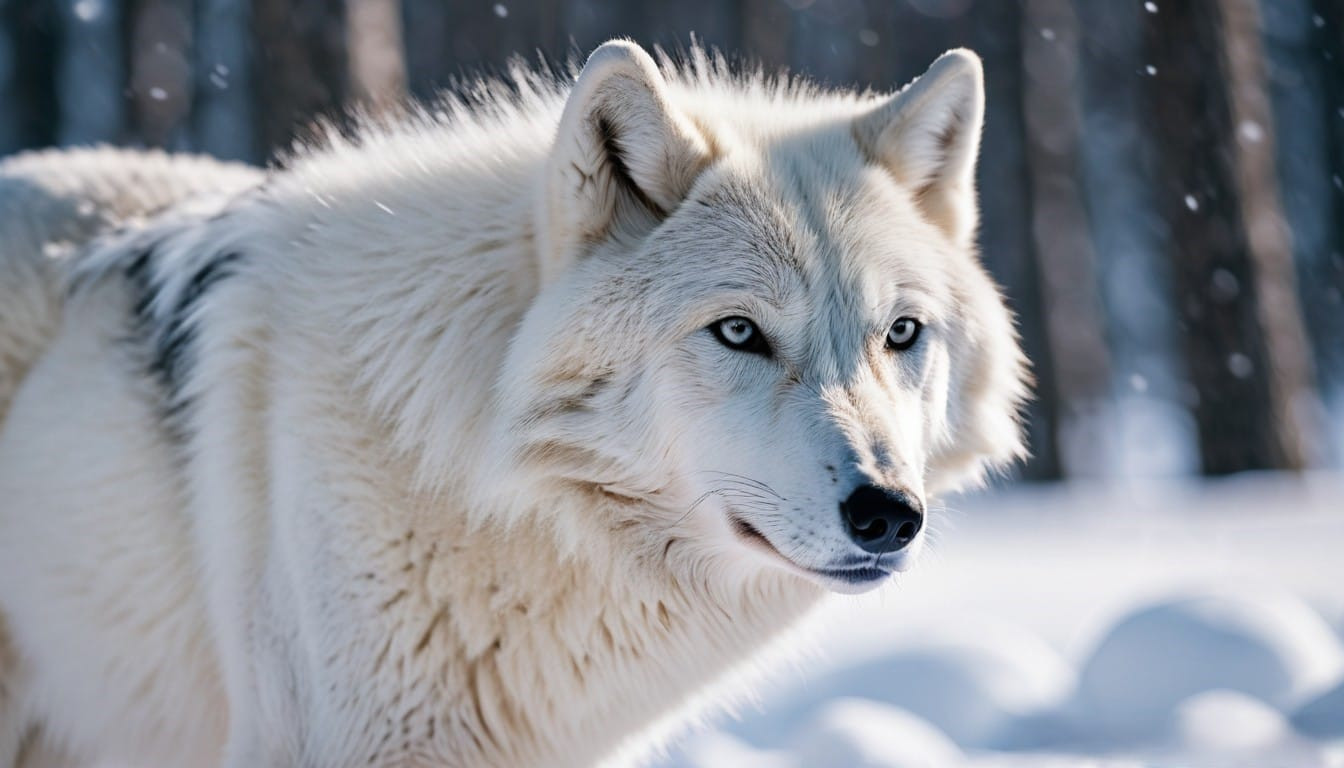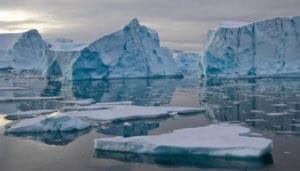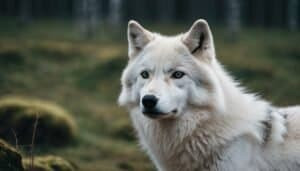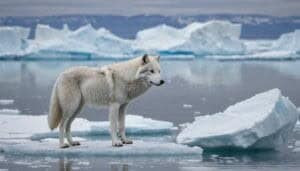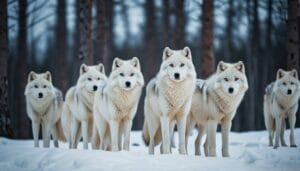Introduction
The melting of Arctic ice has profound effects on the region’s ecosystems, particularly on the Arctic wolves that call it home. This article explores how these changes impact their habitat, prey availability, hunting patterns, survival challenges, and overall health
Additionally, we’ll delve into the long-term ecological implications and the conservation efforts aimed at protecting these resilient predators
Impact of Melting Arctic Ice on the Habitat of Arctic Wolves
The Arctic ice is a critical component of the ecosystem that Arctic wolves rely on. As the ice melts due to rising temperatures, the wolves face significant changes to their habitat, which directly impacts their way of life
Changes in Terrain and Shelter
One of the most immediate impacts of melting Arctic ice is the transformation of the terrain. Arctic wolves traditionally navigate across vast expanses of sea ice to hunt and migrate. With the ice retreating, the landscape becomes fragmented, creating barriers and isolating wolf populations
This fragmented terrain forces wolves to cover greater distances to find food and shelter, expending more energy and increasing the risk of starvation
The loss of sea ice also reduces the availability of traditional dens and shelters. Arctic wolves often rely on ice caves and snow dens to protect their pups from the harsh weather and predators
As these natural shelters disappear, wolves must seek alternative habitats, which are often less secure and more exposed to the elements and potential threats
Loss of Sea Ice and Migration Patterns
Sea ice serves as a crucial platform for Arctic wolves, not just for hunting but also for migration. Wolves migrate across ice sheets to follow their prey and avoid competition
The reduction in sea ice coverage disrupts these migratory routes, making it challenging for wolves to reach essential hunting grounds
With the changing ice conditions, wolves are forced to adapt their migration patterns. They might venture into unfamiliar territories, leading to increased encounters with human activities and infrastructure. These encounters can result in conflicts, further threatening the survival of Arctic wolves. The altered migration patterns also mean that wolves might miss seasonal prey movements, leading to periods of food scarcity
The cumulative effects of these habitat changes are profound. Arctic wolves must navigate an increasingly unpredictable environment, where traditional knowledge and instincts are less reliable
This uncertainty not only affects their immediate survival but also has long-term implications for the population dynamics and genetic diversity of Arctic wolves
Effects on Prey Availability and Hunting Patterns
As Arctic ice continues to melt, the effects on the prey availability and hunting patterns of Arctic wolves are substantial. The changing environment impacts not only the wolves directly but also the species they rely on for food, leading to a cascade of ecological changes
Shifts in Prey Populations
The primary prey for Arctic wolves includes animals such as muskoxen, Arctic hares, and caribou, which are all affected by the changing climate and melting ice. These species depend on specific habitats that are also being transformed
For example, caribou migrations are closely tied to the presence of sea ice and specific vegetation. As these conditions shift, caribou may alter their migration routes or decline in numbers, making them less accessible to wolves
Furthermore, the warmer temperatures and reduced ice cover can lead to an influx of new species into the Arctic, altering the prey dynamics. Species such as red foxes, which compete with Arctic wolves for similar prey, are moving northwards
This increased competition can lead to reduced food availability for wolves, putting additional pressure on their survival
Adaptations in Hunting Strategies
Arctic wolves are highly adaptable predators, but the rapid changes in their environment force them to alter their hunting strategies. Traditionally, wolves use the sea ice to track and ambush their prey. With the ice retreating, these strategies become less effective. Wolves may need to hunt in unfamiliar terrain, which requires different tactics and increased energy expenditure
The melting ice also affects the visibility and accessibility of prey. For instance, muskoxen and hares may become more dispersed in the absence of ice, making it harder for wolves to locate and capture them
Wolves might need to hunt smaller prey or scavenge more frequently, which does not provide the same nutritional benefits as larger kills
Increased Competition and Starvation
The shifts in prey populations and hunting grounds lead to increased competition among Arctic wolves and other predators. As prey becomes scarcer, wolves may face higher competition from both within their packs and from other species. This competition can result in lower hunting success rates, forcing wolves to expend more energy for less food
Starvation becomes a significant risk as a result of these changes. With less reliable access to prey, wolves may experience longer periods of food scarcity, leading to malnutrition and weakened physical conditions
This impacts not only individual wolves but also their ability to care for their young, affecting the overall population’s growth and stability
The cumulative effect of these hunting and prey challenges is a strain on the Arctic wolf population. They are forced to adapt rapidly to a changing environment, with mixed success. The increased difficulty in securing food has profound implications for their survival, reproduction, and long-term viability in the Arctic ecosystem
Survival Challenges and Health Implications
The melting of Arctic ice introduces numerous survival challenges and health implications for Arctic wolves. As their environment transforms, these wolves face increased risks to their physical well-being and breeding success, threatening the long-term stability of their populations
Physical Health and Breeding Patterns
Physical Health
The changing Arctic environment impacts the physical health of Arctic wolves in several ways. Firstly, the increased difficulty in finding food leads to prolonged periods of starvation and malnutrition
Wolves that cannot secure enough prey suffer from weakened immune systems, making them more susceptible to diseases and parasites. The harsh conditions also mean that injured or sick wolves are less likely to recover, further diminishing the health of the population
Additionally, the changing ice conditions force wolves to travel greater distances to find food and shelter, leading to increased physical exertion. This constant search for resources puts a significant strain on their bodies, especially during the colder months when energy reserves are already low
The lack of stable ice platforms also means wolves are often exposed to more dangerous terrain, increasing the risk of injuries
Breeding Patterns
The melting ice and altered habitats also have a profound impact on the breeding patterns of Arctic wolves. Traditionally, wolves rely on specific den sites that provide protection and insulation for their pups
As these sites become less available due to melting ice and changing terrain, wolves may struggle to find suitable places to raise their young. This can lead to lower pup survival rates, as exposed dens are more vulnerable to predators and harsh weather conditions
The nutritional stress caused by decreased prey availability also affects breeding success. Female wolves require substantial energy reserves to reproduce and care for their pups. Malnourished females are less likely to conceive, and if they do, they may not have the necessary strength to care for their offspring. This results in smaller litter sizes and higher pup mortality rates
Moreover, the increased competition for limited resources can disrupt social structures within wolf packs. Stable pack dynamics are crucial for successful breeding, as they ensure cooperative hunting and pup-rearing
Disruptions caused by food scarcity can lead to increased aggression and instability within packs, further hindering breeding success
Long-term Ecological Impacts and Conservation Efforts
The melting of Arctic ice not only impacts individual Arctic wolves but also has broader ecological consequences. These long-term impacts necessitate concerted conservation efforts to ensure the survival of these iconic predators and the overall health of the Arctic ecosystem
Changes in the Arctic Ecosystem
The Arctic ecosystem is a delicate balance of interdependent species, and the melting ice disrupts this balance. As the ice retreats, the habitats of various Arctic species, including the wolves’ prey, undergo significant changes
For instance, the decline in sea ice affects marine mammals like seals, which are a vital food source for polar bears and occasionally for wolves. This leads to increased competition among predators
The changes in vegetation due to warmer temperatures also affect herbivores like caribou and muskoxen. These species may alter their grazing patterns or migrate to new areas, impacting the availability of food for Arctic wolves
The introduction of new species into the Arctic due to climate change further complicates the ecosystem dynamics, creating new challenges for wolves and other native species
Role of Arctic Wolves in the Food Chain
Arctic wolves play a crucial role in maintaining the balance of the Arctic food chain. As apex predators, they help regulate the populations of herbivores, which in turn affects vegetation dynamics. The decline or displacement of Arctic wolves can lead to an overpopulation of certain prey species, resulting in overgrazing and degradation of the tundra
Furthermore, the presence of wolves influences the behavior and distribution of their prey, contributing to the overall health of the ecosystem. The loss of wolves could lead to unforeseen consequences, disrupting the ecological balance and diminishing biodiversity in the region
International Policies and Agreements
Addressing the challenges faced by Arctic wolves requires international cooperation and effective policies. Various international agreements aim to combat climate change and protect Arctic habitats. The Paris Agreement, for example, seeks to limit global temperature rise, which is crucial for preserving sea ice
Conservation organizations also work on global and local levels to protect Arctic species and their habitats. These efforts include advocating for sustainable practices, reducing greenhouse gas emissions, and implementing measures to mitigate the impacts of climate change
Local Conservation Initiatives
Local initiatives are equally important in protecting Arctic wolves. Indigenous communities, who have coexisted with Arctic wildlife for generations, play a key role in conservation efforts. Their traditional knowledge and practices contribute to sustainable management of natural resources and wildlife
Collaborative projects involving scientists, conservationists, and local communities focus on monitoring wolf populations, studying their behavior and health, and developing strategies to mitigate human-wildlife conflicts
These initiatives often include habitat restoration, anti-poaching measures, and public education campaigns to raise awareness about the importance of Arctic wolves and their conservation
Conclusion
The melting of Arctic ice profoundly affects Arctic wolves, presenting numerous challenges to their habitat, prey availability, hunting patterns, and overall health. These predators, adapted to a world of ice and snow, find themselves navigating an increasingly unpredictable environment
The changes in terrain and loss of traditional shelters force Arctic wolves to travel greater distances and expend more energy to survive. The altered migration patterns of their prey, coupled with increased competition from other species, make hunting more difficult and starvation more likely
These factors contribute to the declining physical health and disrupted breeding patterns of Arctic wolves, threatening the stability of their populations
The broader ecological impacts of melting ice extend beyond Arctic wolves. As apex predators, they play a crucial role in maintaining the balance of the Arctic ecosystem. Their decline could lead to overpopulation of prey species, resulting in habitat degradation and reduced biodiversity
Conservation efforts are essential to mitigate these impacts. International policies aimed at combating climate change, coupled with local initiatives and the involvement of Indigenous communities, provide a multifaceted approach to protecting Arctic wolves and their habitats
These efforts include habitat restoration, monitoring wolf populations, and addressing human-wildlife conflicts
Ultimately, the survival of Arctic wolves depends on our collective ability to address the underlying causes of climate change and implement effective conservation strategies. By preserving these iconic predators, we contribute to the health and resilience of the Arctic ecosystem as a whole
